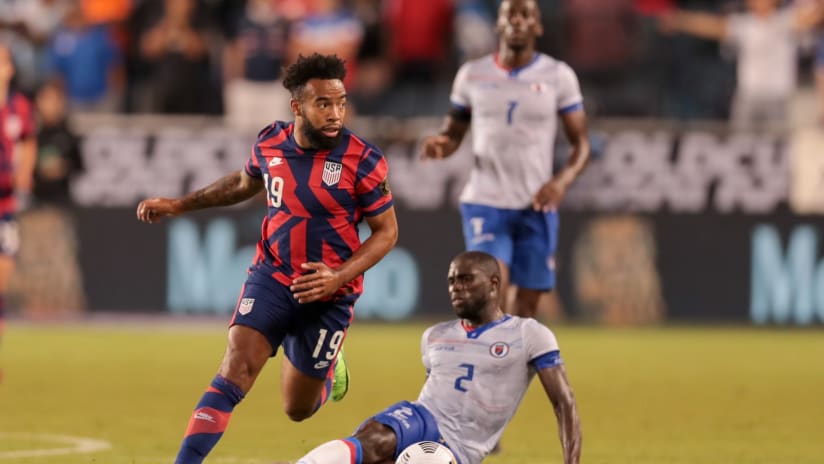PORTLAND, Oregon – The fact that the inaugural 2014 Chipotle MLS Homegrown Game even took place — the MLS version of a "Futures Game" — was in itself a clear sign of the upward trajectory of soccer development in the US and Canada.
But you can make the argument that the bigger statement made on Monday night was the fact that the Homegrown team of MLS professional players were at times outplayed by the Portland Timbers Under-23s — a team of Timbers academy products and college players, some who only joined the PDL side last week.
"Towards the end of the game we had more clear chances than them," said standout Timbers right back Dennis Castillo, who attends Virginia Commonwealth University. "It felt a little sad because we should have won. But it was a great experience."
It's true that the MLS Homegrowns only had a 24-hour training session prior to the match and star players like Gyasi Zardes and Shane O'Neill didn't feature. But it was still notable that the Timbers U-23s were able to hold their own and even bossed the game for stretches.
Now imagine what level they could reach if those Timbers U-23 players were able to train year round as a team instead of a mere three months during the PDL season.
At Monday's All-Star press conference, New York Red Bulls star Thierry Henry opined on the theme of US player development and noted the 10-year head start players in Europe have compared to US college products, who turn pro at the ages of 22-24.
"Kids coming into the pros at 22-23 years old, it's tough," All-Star head coach Caleb Porter said. "It's the first time they’ve played or started and the first time they've been tested and suffered. We need to start earlier and develop better environments from top to bottom.
"The key in developing players is the environment and time," Porter continued. "The sooner you can get kids in a high level environment that’s close to high level as possible, the more time you get in that environment, the more players you’ll develop.
Castillo agrees. He's from Costa Rica and came through the Saprissa youth system, playing regularly for their second-division affiliate side and getting training with the senior team everyday. Then again, he wasn't taking on a full course load.
"It was totally a change of routine and it was tough in the beginning," Castillo said about his arrival to the USA three years ago. "But as it went on I started to realize how the system works with a college."
It's more stop-start for even the elite soccer players in the college system. Although there's discussion of extending the college season into spring, the NCAA competitive season currently only runs four months. There's a mandated winter break for catching up on school work and players wind up seeking training on their own.
Timbers Under-23 head coach Jim Rilatt got a firsthand taste of it in US Open Cup play soon after his team assembled for the 2014 season. The Timbers U-23s jumped out to a 2-0 lead at home against Arizona United only to collapse to a 3-2 home 2nd-round defeat.
"I asked them what they had been doing," Rilatt said about his players' lead-up to the match. "After the spring [college exhibitions], they stopped for 2-3 weeks of study and after three weeks you're not able to keep up. That's an offseason."
The Timbers' No. 10 on Monday night, James Moberg, played the Diego Valeri role for the U-23s and was one of the busiest players on the field. But he only joined the team last week just before heading back to the University of Washington. In addition to the week with the Timbers U-23s, Moberg has pieced together his soccer for 2014: a spring college exhibition season, a college soccer trip to Sweden and some time with California club team Atletico Santa Rosa.
"I'd love to train in the mornings every single day. That's what you want," Moberg said. "It's a bummer if you're not playing PDL or a summer league team."
"Of course you would get so much better [if you trained everyday]," noted Castillo, who says he spent about two weeks of training with the Timbers' senior team this summer as part of his PDL experience. "But here [in the USA] you don't have that kind of system. It is what it is. The system has to change. That's the answer. The system has to change in order for the young players to get better."
The current system may not be perfect, but it's not that bad either. The Homegrown match may have finished scoreless, but both coaches say there was real quality on the field.
And the future is bright: the Timbers expect more and more of their college-bound academy kids to be part of their U-23 squad. On Monday they had a 14-year-old, Adrian Villegas, in their 18-man gameday squad.
"The way the game was played and the entertainment for the crowd, it's not bad for American soccer right now," Rilatt said of Monday's match. "And that's not bad for young kids."












